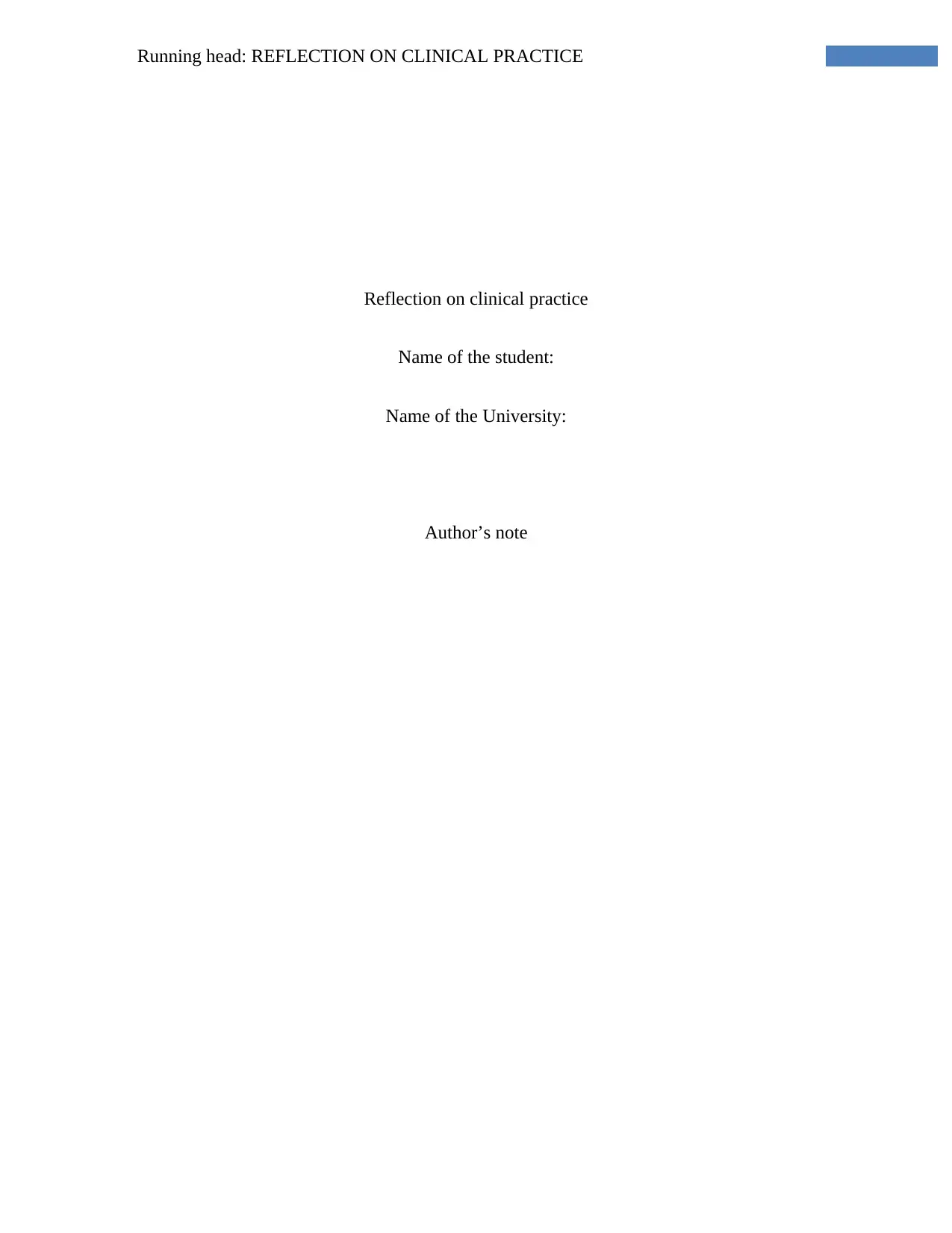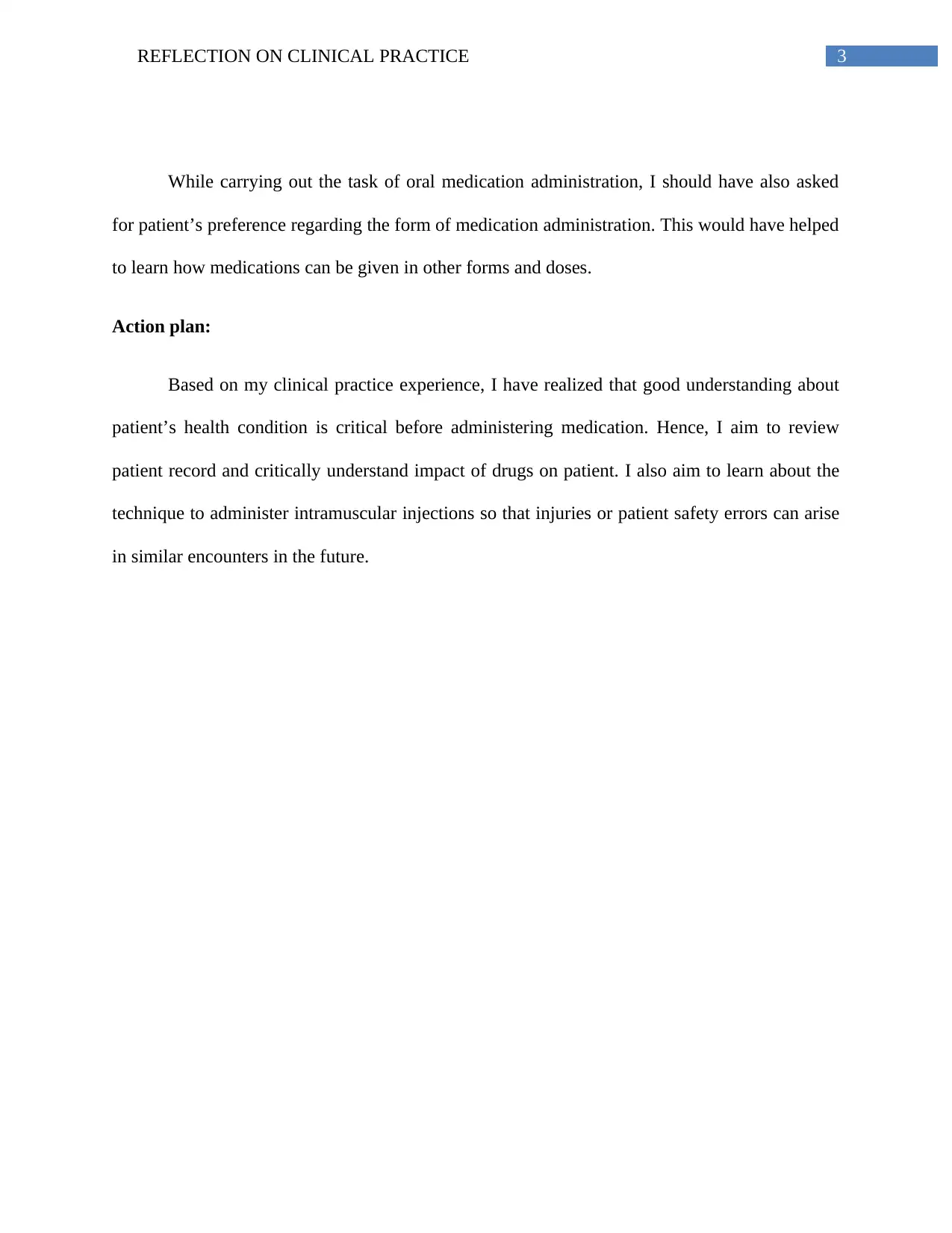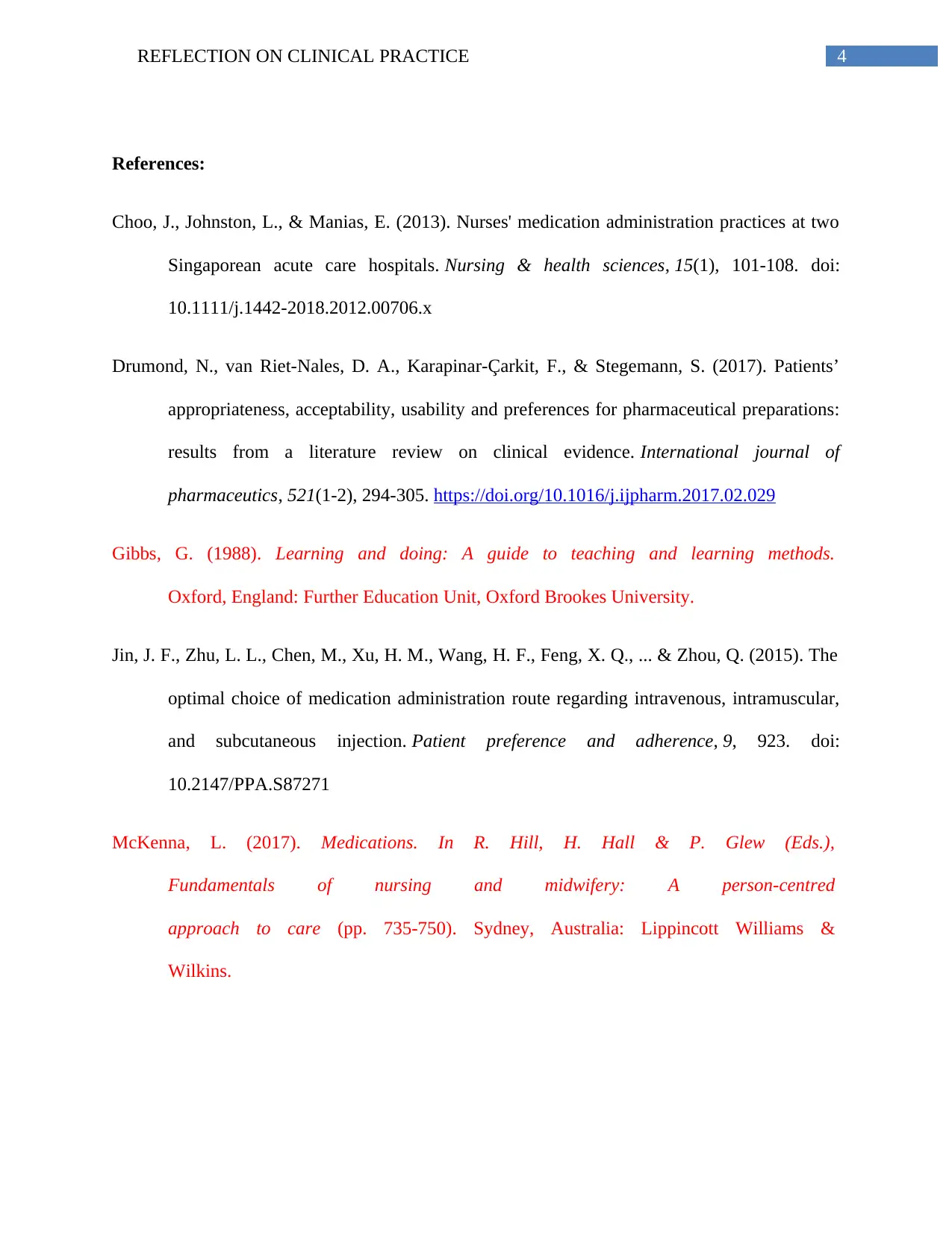Reflective Journal: Clinical Practice & Medication Administration
VerifiedAdded on 2023/06/07
|6
|1140
|137
Journal and Reflective Writing
AI Summary
This reflective journal entry details a nursing student's experience administering medication during clinical practice. The student reflects on administering oral medication following the five rights, observing a colleague's proper subcutaneous injection technique, and witnessing another's incorrect intramuscular injection leading to patient discomfort. The reflection employs Gibb’s reflective cycle to analyze the situations, highlighting the importance of proper technique, patient consent, and understanding drug impacts. The student identifies areas for improvement, such as considering patient preferences for medication forms and mastering intramuscular injection techniques to prevent future errors. The reflection emphasizes the need for a comprehensive understanding of patient health conditions and medication effects before administration, with a commitment to reviewing patient records and improving injection skills.

Running head: REFLECTION ON CLINICAL PRACTICE
Reflection on clinical practice
Name of the student:
Name of the University:
Author’s note
Reflection on clinical practice
Name of the student:
Name of the University:
Author’s note
Paraphrase This Document
Need a fresh take? Get an instant paraphrase of this document with our AI Paraphraser

1REFLECTION ON CLINICAL PRACTICE
Description:
During my clinical practice unit session, I and two other nursing students were assigned
the task administering medication to different types of patients. Based on our classes related to
medication administration, the session was meant to test our skills in medication administration.
We all had to administer medication through different modes. Things went very well for the
person who was administering subcutaneous medication as she followed all good practices. I also
witnessed poor practice of a colleague which creates issues during medication administration.
Gibb’s reflective cycle has been used to describe the situations and the lessons I learnt through
the experience (Gibbs, 1988).
Feelings:
While completing this activity, I was confident as I had prepared very well regarding all
the elements of safe medication administration. However, I knew that medication administration
in a practical environment is different than just theoretical learning. Hence, I was observing the
skills and activities of other nursing students to identify good or poor practice related to
medication administration.
Evaluation:
As I had the responsibility of administering oral medication, I started by following the
five rights of medication administration. I first started with confirming patient’s identity by
reviewing arm band. Then I followed the other four elements of right drug, right dose, right route
and right time. The generic name, dose required, expiry date, sensitivity to the drug and drugs
taken by patient was reviewed (Parry, Barriball & While, 2015). This was a good practice which
helped me to ensure right drug was being given to the right person. During medication
Description:
During my clinical practice unit session, I and two other nursing students were assigned
the task administering medication to different types of patients. Based on our classes related to
medication administration, the session was meant to test our skills in medication administration.
We all had to administer medication through different modes. Things went very well for the
person who was administering subcutaneous medication as she followed all good practices. I also
witnessed poor practice of a colleague which creates issues during medication administration.
Gibb’s reflective cycle has been used to describe the situations and the lessons I learnt through
the experience (Gibbs, 1988).
Feelings:
While completing this activity, I was confident as I had prepared very well regarding all
the elements of safe medication administration. However, I knew that medication administration
in a practical environment is different than just theoretical learning. Hence, I was observing the
skills and activities of other nursing students to identify good or poor practice related to
medication administration.
Evaluation:
As I had the responsibility of administering oral medication, I started by following the
five rights of medication administration. I first started with confirming patient’s identity by
reviewing arm band. Then I followed the other four elements of right drug, right dose, right route
and right time. The generic name, dose required, expiry date, sensitivity to the drug and drugs
taken by patient was reviewed (Parry, Barriball & While, 2015). This was a good practice which
helped me to ensure right drug was being given to the right person. During medication

2REFLECTION ON CLINICAL PRACTICE
administration, I took the step to take informed consent from patient and helped the patient to
take a comfortable position (McKenna, 2017). I used appropriate medication dispensing device
and a distraction free environment was maintained during medication administration (Choo,
Johnston & Manias, 2013). Everything went well for me also because patient had no additional
complaints that could create issues for me during medication administration.
In addition, I also got to learn about the good practice related to subcutaneous medication
administration while observing the activity of my classmate. I saw my colleague selecting the
right location and considering injection site rotation too as the patient has got many such
subcutaneous injections before. I identified the good practice for selecting appropriate location
and patient preference as useful as subcutaneous injections are given in arms, thighs and
abdomens and the patient preference and review of last injective given helps to decide the best
site (Jin et al., 2015). However, the second nursing student made mistakes during intramuscular
administration as she was supposed to palpate the site and provide injection using 90 degree
angle. However, she was nervous and injected the drug from a wrong angle leading to pain and
discomfort for the patient (Souza et al., 2018).
Analysis:
My own activity of administering oral medication gave me the learning regarding the
importance of following the five rights of medication administration. However, witnessing the
poor practice of my classmate who provided intramuscular injection from a wrong angle, I have
realized that there are many elements to be considered while administering intramuscular drugs.
Hence, I aim to learn about prescription, dispensing, distribution and administration of the drug.
Alternative action:
administration, I took the step to take informed consent from patient and helped the patient to
take a comfortable position (McKenna, 2017). I used appropriate medication dispensing device
and a distraction free environment was maintained during medication administration (Choo,
Johnston & Manias, 2013). Everything went well for me also because patient had no additional
complaints that could create issues for me during medication administration.
In addition, I also got to learn about the good practice related to subcutaneous medication
administration while observing the activity of my classmate. I saw my colleague selecting the
right location and considering injection site rotation too as the patient has got many such
subcutaneous injections before. I identified the good practice for selecting appropriate location
and patient preference as useful as subcutaneous injections are given in arms, thighs and
abdomens and the patient preference and review of last injective given helps to decide the best
site (Jin et al., 2015). However, the second nursing student made mistakes during intramuscular
administration as she was supposed to palpate the site and provide injection using 90 degree
angle. However, she was nervous and injected the drug from a wrong angle leading to pain and
discomfort for the patient (Souza et al., 2018).
Analysis:
My own activity of administering oral medication gave me the learning regarding the
importance of following the five rights of medication administration. However, witnessing the
poor practice of my classmate who provided intramuscular injection from a wrong angle, I have
realized that there are many elements to be considered while administering intramuscular drugs.
Hence, I aim to learn about prescription, dispensing, distribution and administration of the drug.
Alternative action:
⊘ This is a preview!⊘
Do you want full access?
Subscribe today to unlock all pages.

Trusted by 1+ million students worldwide

3REFLECTION ON CLINICAL PRACTICE
While carrying out the task of oral medication administration, I should have also asked
for patient’s preference regarding the form of medication administration. This would have helped
to learn how medications can be given in other forms and doses.
Action plan:
Based on my clinical practice experience, I have realized that good understanding about
patient’s health condition is critical before administering medication. Hence, I aim to review
patient record and critically understand impact of drugs on patient. I also aim to learn about the
technique to administer intramuscular injections so that injuries or patient safety errors can arise
in similar encounters in the future.
While carrying out the task of oral medication administration, I should have also asked
for patient’s preference regarding the form of medication administration. This would have helped
to learn how medications can be given in other forms and doses.
Action plan:
Based on my clinical practice experience, I have realized that good understanding about
patient’s health condition is critical before administering medication. Hence, I aim to review
patient record and critically understand impact of drugs on patient. I also aim to learn about the
technique to administer intramuscular injections so that injuries or patient safety errors can arise
in similar encounters in the future.
Paraphrase This Document
Need a fresh take? Get an instant paraphrase of this document with our AI Paraphraser

4REFLECTION ON CLINICAL PRACTICE
References:
Choo, J., Johnston, L., & Manias, E. (2013). Nurses' medication administration practices at two
Singaporean acute care hospitals. Nursing & health sciences, 15(1), 101-108. doi:
10.1111/j.1442-2018.2012.00706.x
Drumond, N., van Riet-Nales, D. A., Karapinar-Çarkit, F., & Stegemann, S. (2017). Patients’
appropriateness, acceptability, usability and preferences for pharmaceutical preparations:
results from a literature review on clinical evidence. International journal of
pharmaceutics, 521(1-2), 294-305. https://doi.org/10.1016/j.ijpharm.2017.02.029
Gibbs, G. (1988). Learning and doing: A guide to teaching and learning methods.
Oxford, England: Further Education Unit, Oxford Brookes University.
Jin, J. F., Zhu, L. L., Chen, M., Xu, H. M., Wang, H. F., Feng, X. Q., ... & Zhou, Q. (2015). The
optimal choice of medication administration route regarding intravenous, intramuscular,
and subcutaneous injection. Patient preference and adherence, 9, 923. doi:
10.2147/PPA.S87271
McKenna, L. (2017). Medications. In R. Hill, H. Hall & P. Glew (Eds.),
Fundamentals of nursing and midwifery: A person-centred
approach to care (pp. 735-750). Sydney, Australia: Lippincott Williams &
Wilkins.
References:
Choo, J., Johnston, L., & Manias, E. (2013). Nurses' medication administration practices at two
Singaporean acute care hospitals. Nursing & health sciences, 15(1), 101-108. doi:
10.1111/j.1442-2018.2012.00706.x
Drumond, N., van Riet-Nales, D. A., Karapinar-Çarkit, F., & Stegemann, S. (2017). Patients’
appropriateness, acceptability, usability and preferences for pharmaceutical preparations:
results from a literature review on clinical evidence. International journal of
pharmaceutics, 521(1-2), 294-305. https://doi.org/10.1016/j.ijpharm.2017.02.029
Gibbs, G. (1988). Learning and doing: A guide to teaching and learning methods.
Oxford, England: Further Education Unit, Oxford Brookes University.
Jin, J. F., Zhu, L. L., Chen, M., Xu, H. M., Wang, H. F., Feng, X. Q., ... & Zhou, Q. (2015). The
optimal choice of medication administration route regarding intravenous, intramuscular,
and subcutaneous injection. Patient preference and adherence, 9, 923. doi:
10.2147/PPA.S87271
McKenna, L. (2017). Medications. In R. Hill, H. Hall & P. Glew (Eds.),
Fundamentals of nursing and midwifery: A person-centred
approach to care (pp. 735-750). Sydney, Australia: Lippincott Williams &
Wilkins.

5REFLECTION ON CLINICAL PRACTICE
Parry, A. M., Barriball, K. L., & While, A. E. (2015). Factors contributing to Registered Nurse
medication administration error: A narrative review. International journal of nursing
studies, 52(1), 403-420. https://doi.org/10.1016/j.ijnurstu.2014.07.003
Souza, T. L. V. D., Mota, R. D. O., Brito, E. A. W. D. S., Farias, L. M. V. C., Matias, É. O., &
Lima, F. E. T. (2018). Patient safety in the administration of intramuscular medication in
pediatrics: assessment of the nursing practice. Revista gaucha de enfermagem, 39(1).
http://dx.doi.org/10.1590/1983-1447.2018.2017-0002
Parry, A. M., Barriball, K. L., & While, A. E. (2015). Factors contributing to Registered Nurse
medication administration error: A narrative review. International journal of nursing
studies, 52(1), 403-420. https://doi.org/10.1016/j.ijnurstu.2014.07.003
Souza, T. L. V. D., Mota, R. D. O., Brito, E. A. W. D. S., Farias, L. M. V. C., Matias, É. O., &
Lima, F. E. T. (2018). Patient safety in the administration of intramuscular medication in
pediatrics: assessment of the nursing practice. Revista gaucha de enfermagem, 39(1).
http://dx.doi.org/10.1590/1983-1447.2018.2017-0002
⊘ This is a preview!⊘
Do you want full access?
Subscribe today to unlock all pages.

Trusted by 1+ million students worldwide
1 out of 6
Related Documents
Your All-in-One AI-Powered Toolkit for Academic Success.
+13062052269
info@desklib.com
Available 24*7 on WhatsApp / Email
![[object Object]](/_next/static/media/star-bottom.7253800d.svg)
Unlock your academic potential
Copyright © 2020–2025 A2Z Services. All Rights Reserved. Developed and managed by ZUCOL.





